Application of Post-Embedded Piezoceramic Sensors for Force Detection on RC Columns under Seismic Loading
Abstract
:1. Introduction
2. Materials and Work Method
2.1. Materials
2.2. Work Method
3. Experiment Results
4. Proposed Method for Detecting Force Applied to a Column Specimen in an Earthquake
4.1. Voltage Signals Generated by Post-Embedded Piezoceramic Sensors under Dynamic Loading
4.2. Proposed Method for Estimating Maximum Applied Force under Dynamic Loading
5. Conclusions
Author Contributions
Funding
Acknowledgments
Conflicts of Interest
References
- Liao, W.I.; Jean, W.Y. Structural health monitoring for local damages of RC walls using piezoceramic-based sensors under seismic loading. In Proceedings of the Earth and Space 2010: Engineering, Science, Construction, and Operations in Challenging Environments, Honolulu, HI, USA, 14–17 March 2017. [Google Scholar]
- Li, H.; Tian, C.; Deng, Z.D. Energy harvesting from low frequency applications using piezoelectric materials. Appl. Phys. Rev. 2014, 1, 041301. [Google Scholar] [CrossRef] [Green Version]
- Gu, H.; Moslehy, Y.; Sanders, D.; Song, G.; Mo, Y.L. Multi-functional smart aggregate-based structural health monitoring of circular reinforced concrete columns subjected to seismic excitations. Smart Mater. Struct. 2010, 19, 065026. [Google Scholar] [CrossRef]
- Liao, W.I.; Wang, J.X.; Song, G.; Gu, H.; Olmi, C.; Mo, Y.L.; Chang, K.C.; Loh, C.H. Structural health monitoring of concrete columns subjected to seismic excitations using piezoceramic-based sensors. Smart Mater. Struct. 2011, 20, 125015. [Google Scholar] [CrossRef]
- Chang, W.; Chai, J.F.; Liao, W.I. Structural health monitoring of a concrete frame subjected to shake table excitations using smart aggregates. In Proceedings of the Pressure Vessels & Piping Conference, Anaheim, CA, USA, 20–24 July 2014. [Google Scholar]
- Liao, W.I.; Hsiao, F.P.; Chiu, C.K.; Ho, C.E. Structural health monitoring and interface damage detection for infill reinforced concrete walls in seismic retrofit of reinforced concrete frames using piezoceramic-based transducers under the cyclic loading. Appl. Sci. 2019, 9, 312. [Google Scholar] [CrossRef] [Green Version]
- Chiu, C.K.; Sung, H.F.; Chi, K.N.; Hsiao, F.P. Experimental Quantification on the Residual Seismic Capacity of Damaged RC Column Members. Int. J. Concr. Struct. Mater. 2019, 13, 17. [Google Scholar] [CrossRef]
- Wang, F.; Chen, Z.; Song, G. Monitoring of multi-bolt connection looseness using entropy-based active sensing and genetic algorithm-based least square support vector machine. Mech. Syst. Signal Proc. 2020, 136, 106507. [Google Scholar] [CrossRef]
- Qin, F.; Kong, Q.; Li, M.; Mo, Y.L.; Song, G.; Fan, F. Bond slip detection of steel plate and concrete beams using smart aggregates. Smart Mater. Struct. 2015, 24, 115039. [Google Scholar] [CrossRef]
- Liang, Y.; Li, D.; Parvasi, S.M.; Kong, Q.; Lim, I.; Song, G. Bond-slip detection of concrete-encased composite structure using electro-mechanical impedance technique. Smart Mater. Struct. 2016, 25, 095003. [Google Scholar] [CrossRef]
- Zeng, L.; Parvasi, S.M.; Kong, Q.; Huo, L.; Lim, I.; Li, M.; Song, G. Bond slip detection of concrete-encased composite structure using shear wave based active sensing approach. Smart Mater. Struct. 2015, 24, 125026. [Google Scholar] [CrossRef]
- Guyomar, D.; Badel, A.; Lefeuvre, E.; Richard, C. Toward energy harvesting using active materials and conversion improvement by nonlinear processing. IEEE Trans. Ultrason. Ferroelectr. Freq. Control 2005, 52, 584–595. [Google Scholar] [CrossRef] [Green Version]
- Wang, G. Analysis of bimorph piezoelectric beam energy harvesters using Timoshenko and Euler-Bernoulli beam theory. J. Intell. Mater. Syst. Struct. 2013, 24, 226–239. [Google Scholar] [CrossRef]
- Lefeuvre, E.; Badel, A.; Richard, C.; Petit, L.; Guyomar, D. A comparison between several vibration-powered piezoelectric generators for standalone systems. Sensors Actuators A Phys. 2009, 126, 405–416. [Google Scholar] [CrossRef]
- Yan, B.; Zhang, S.W.; Zhang, X.N.; Wang, K.; Wu, C.Y. Self-powered electromagnetic energy harvesting for the low power consumption electronics: Design and experiment. Int. J. Appl. Electromagn. Mech. 2017, 54, 165–175. [Google Scholar] [CrossRef]
- Corr, L.R.; Clark, W.W. A Novel SemiActive Multi-Modal Vibration Control Law for a Piezoceramic Actuator. J. Vib. Acoust. 2003, 125, 214–222. [Google Scholar] [CrossRef]
- Niederberger, D.; Fleming, A.; Moheimani, S.O.R.; Morari, M. Adaptive multi-mode resonant piezoelectric shunt damping. Smart Mater. Struct. 2004, 13, 1025. [Google Scholar] [CrossRef] [Green Version]
- Hou, S.; Zhang, H.B.; Ou, J.P. A PZT-based smart aggregate for compressive seismic stress monitoring. Smart Mater. Struct. 2012, 21, 105035. [Google Scholar] [CrossRef]
- Hou, S.; Zhang, H.B.; Ou, J.P. A PZT-based smart aggregate for seismic shear stress monitoring. Smart Mater. Struct. 2013, 22, 65012. [Google Scholar] [CrossRef]
- Li, Y.; Wang, G.; Yang, X. Research on static decoupling algorithm for piezoelectric six axis force/torque sensor based on LSSVR fusion algorithm. Mech. Syst. Signal Proc. 2018, 110, 509–520. [Google Scholar] [CrossRef]
- Noh, Y.; Bimbo, J.; Sareh, S. Multi-axis force/torque sensor based on simply-supported beam and optoelectro- nics. Sensors 2016, 16, 1936. [Google Scholar] [CrossRef] [PubMed] [Green Version]
- Zhang, H.B.; Hou, S.; Ou, J.P. SA-based concrete seismic stress monitoring: The influence of non-uniform stress fields. Eng. Struct. 2019, 190, 66–75. [Google Scholar] [CrossRef]
- Hou, S.; Cui, L.L.; Xu, X. A piezoelectric-based three-direction normal stress sensor for concrete structures. J. Intell. Mater. Syst. Struct. 2019, 30, 1858–1867. [Google Scholar] [CrossRef]
- ASCE (American Society of Civil Engineers). Seismic Rehabilitation of Existing Buildings (ASEC-41); ASCE: Reston, VA, USA, 2006. [Google Scholar]
- JBDPA (Japan Building Disaster Prevention Association). Guideline for Post-Earthquake Damage Evaluation and Rehabilitation; JBDPA: Tokyo, Japan, 2001. [Google Scholar]
- JBDPA (Japan Building Disaster Prevention Association). Standard for Seismic Evaluation of Existing Reinforced Concrete Buildings, Guidelines for Seismic Retrofit of Existing Reinforced Concrete Buildings, and Technical Manual for Seismic Evaluation and Seismic Retrofit of Existing Reinforced Concrete Buildings; JBDPA: Tokyo, Japan, 2015. [Google Scholar]

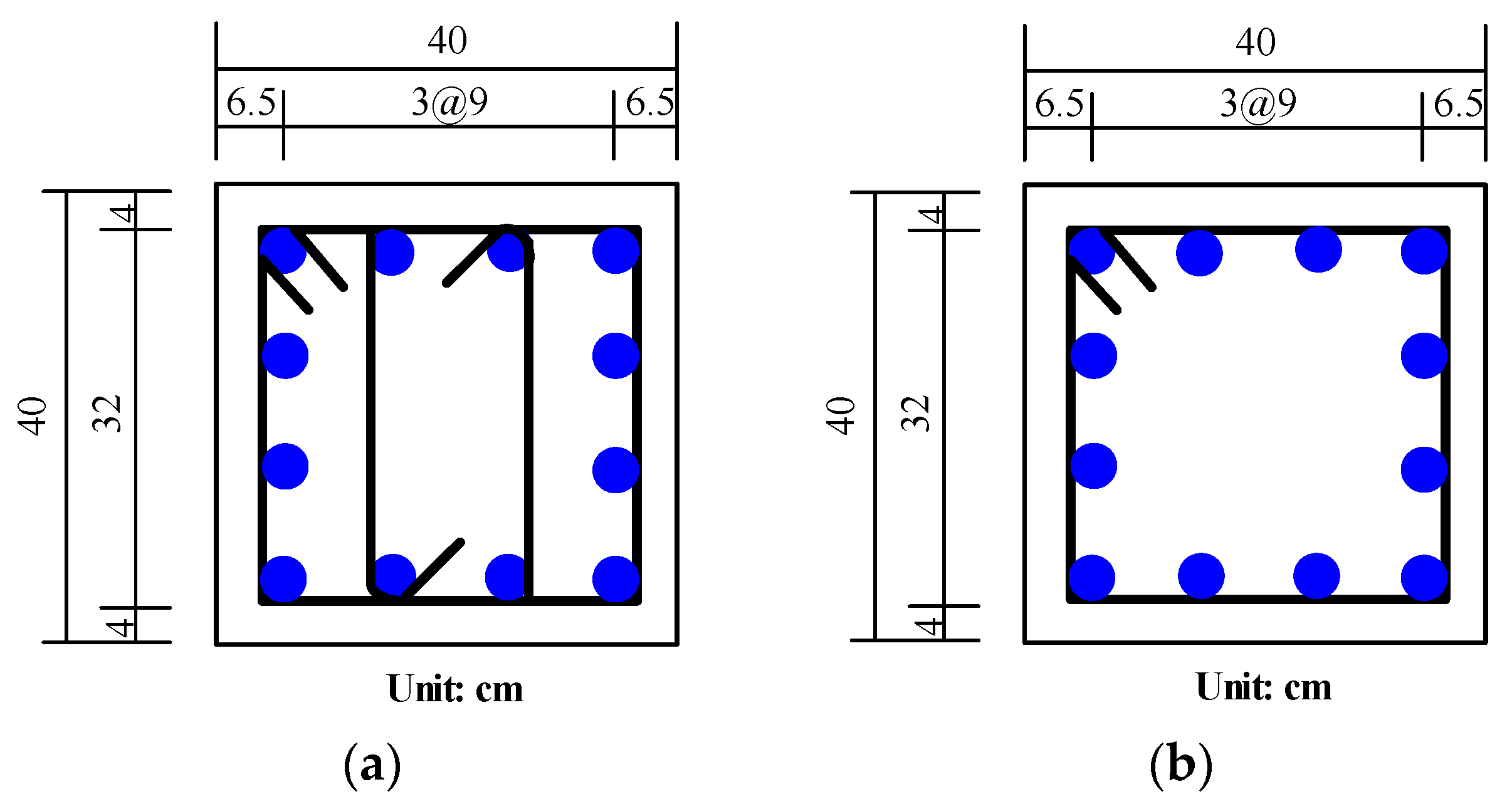
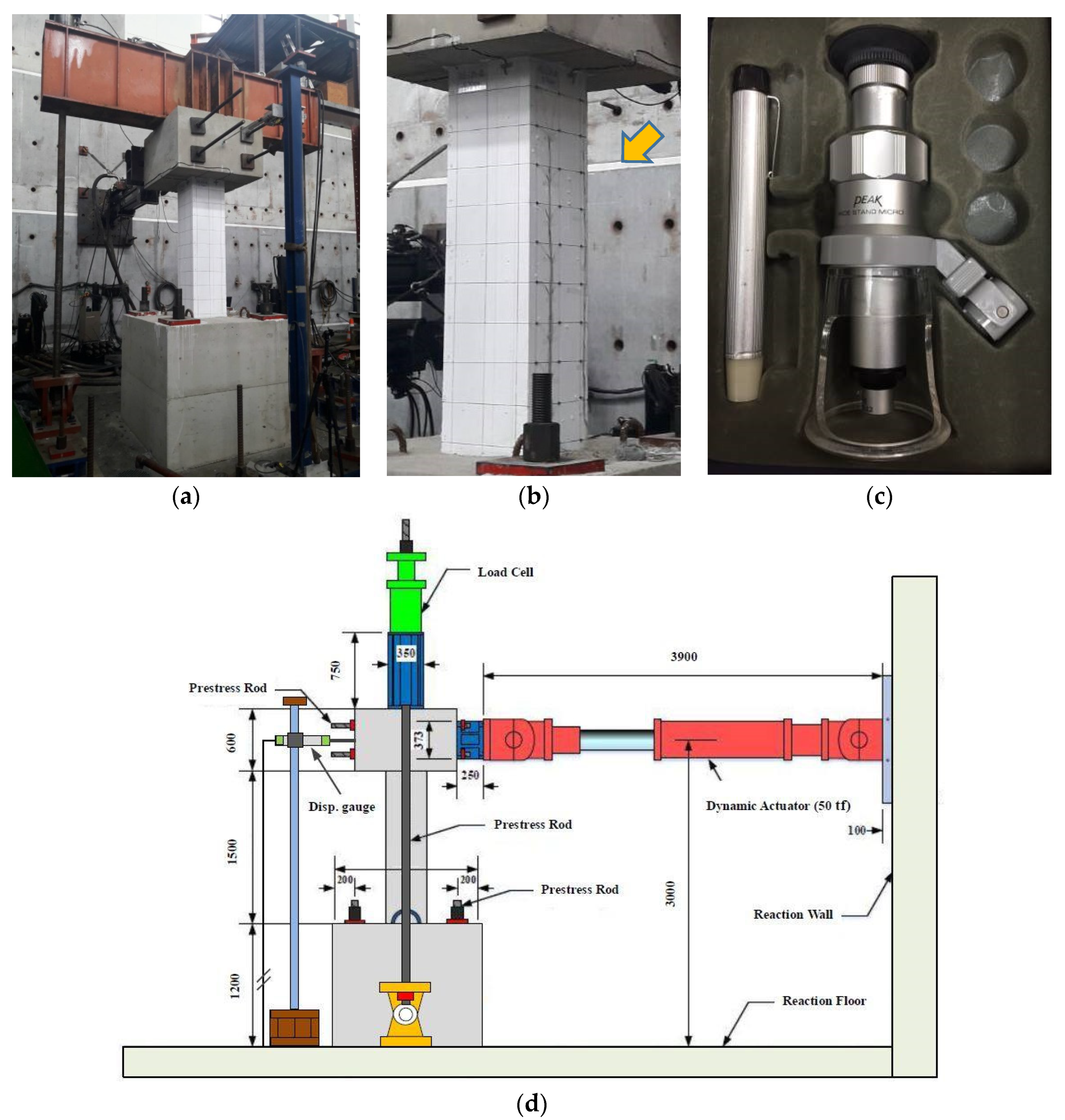

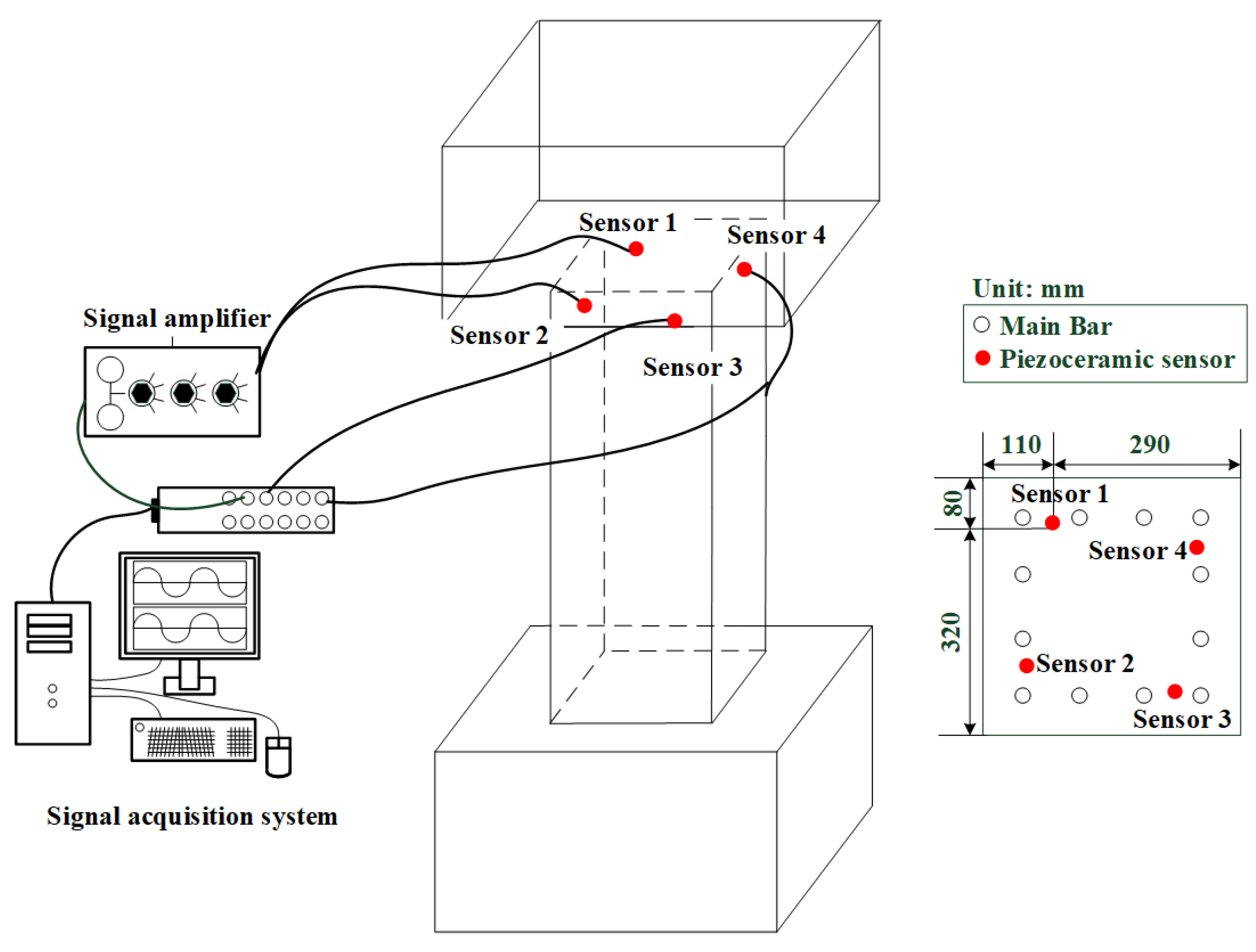
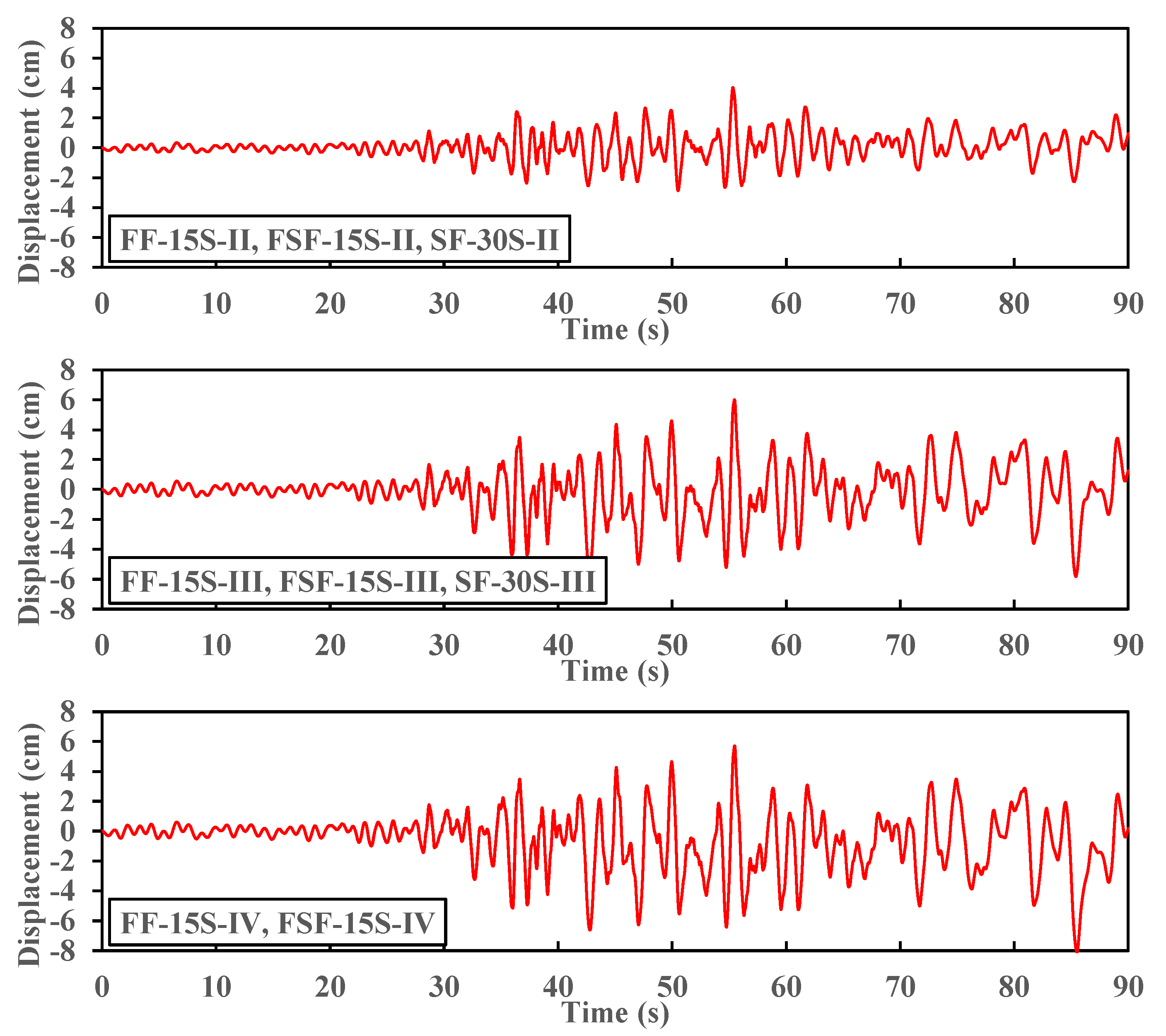

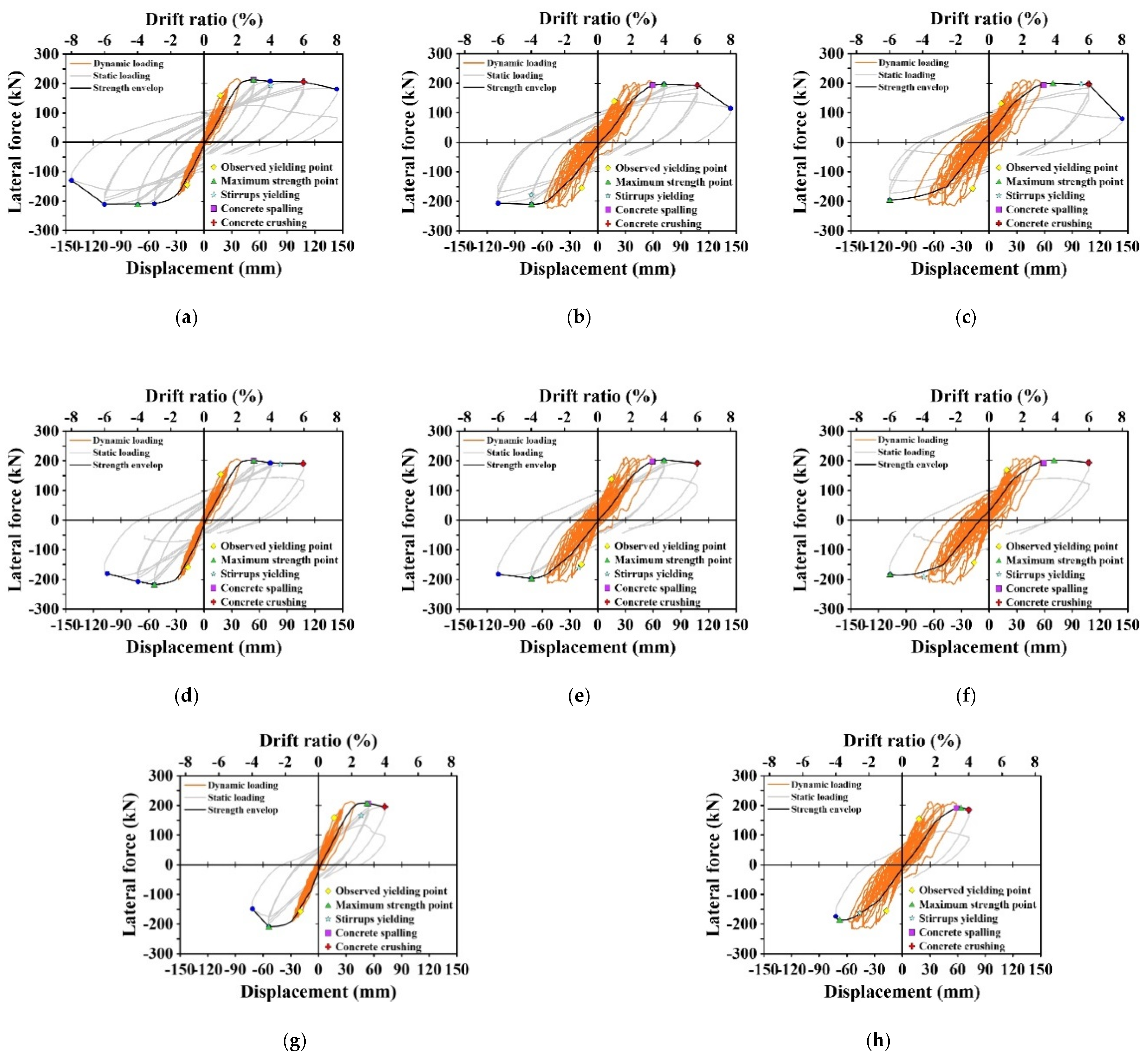
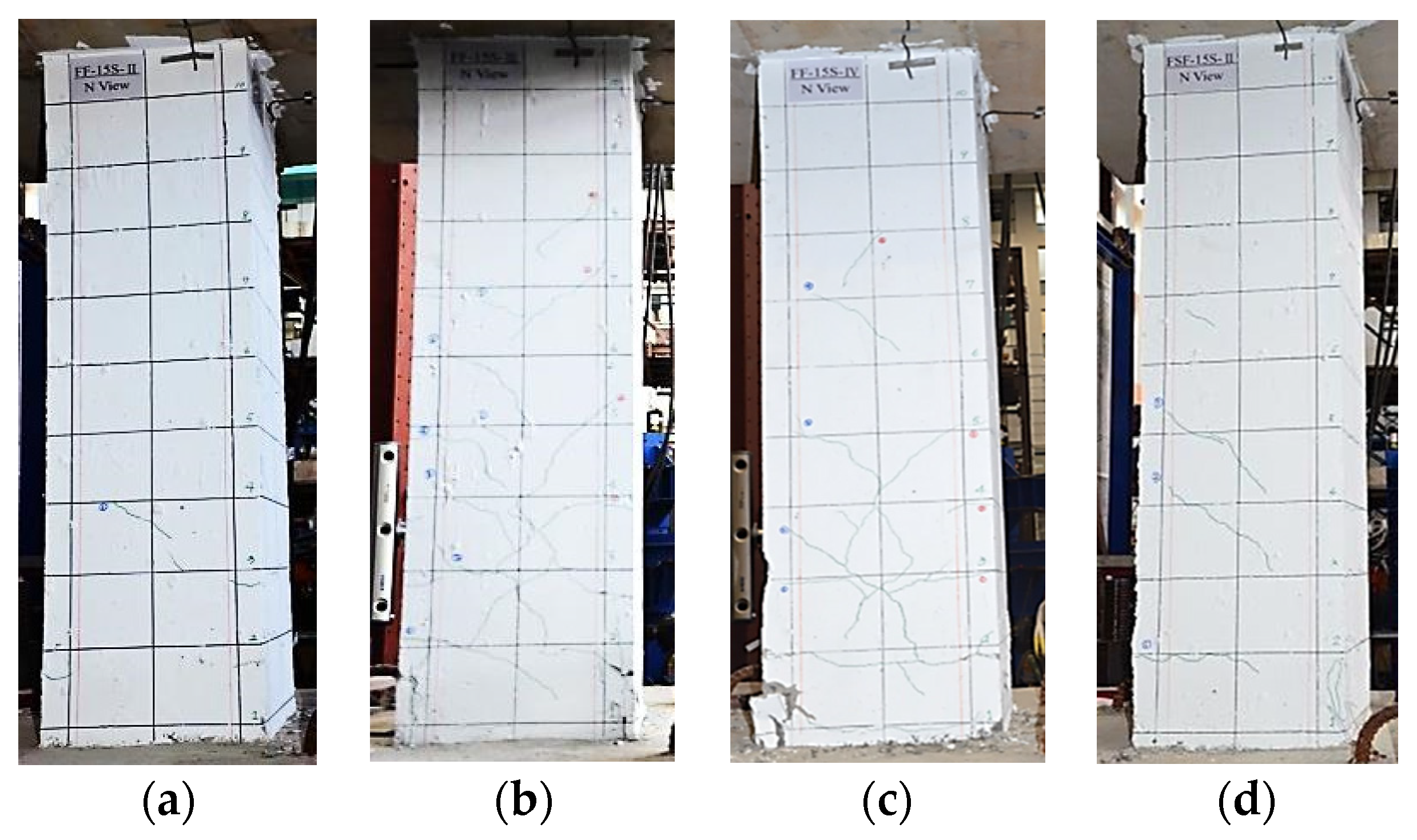
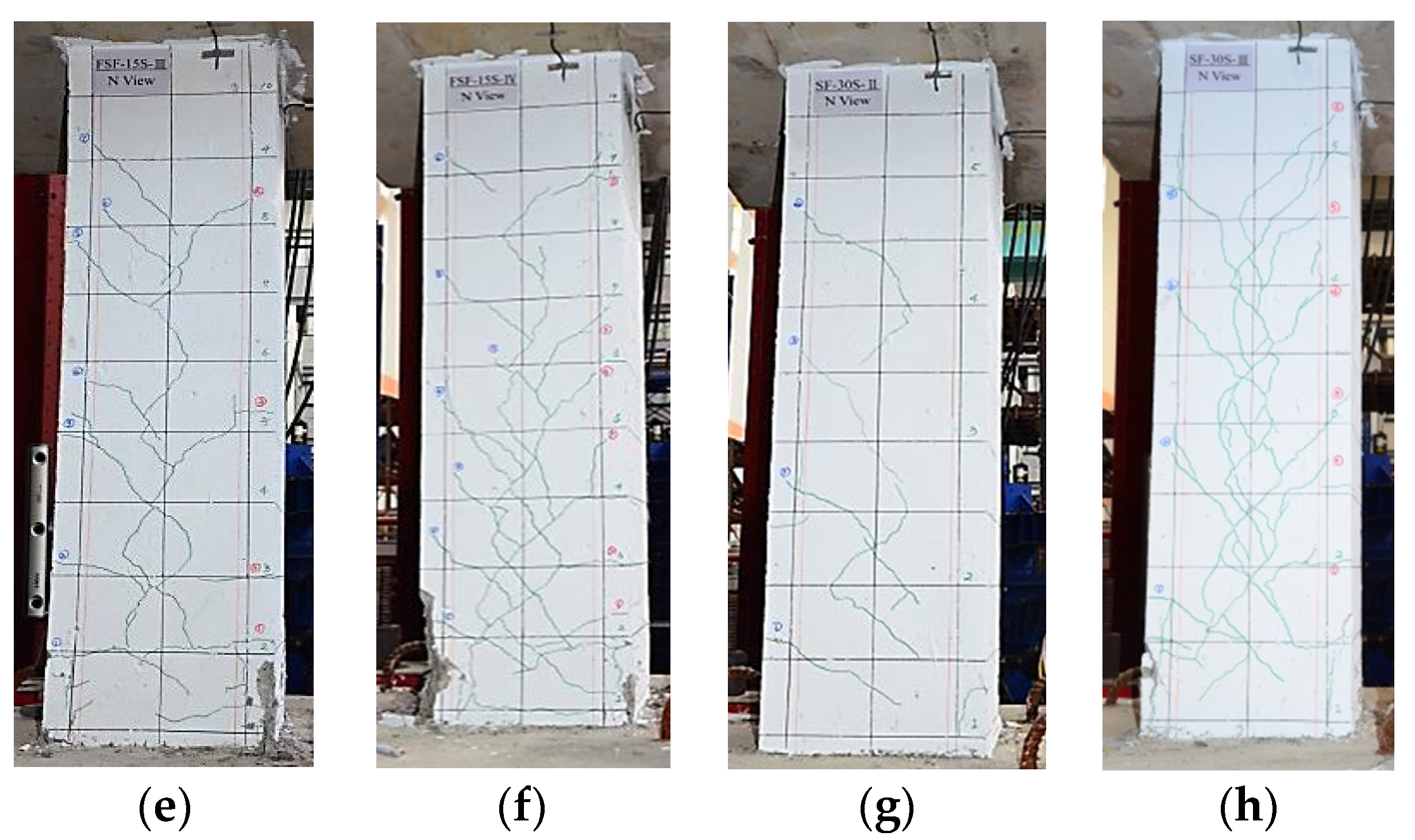




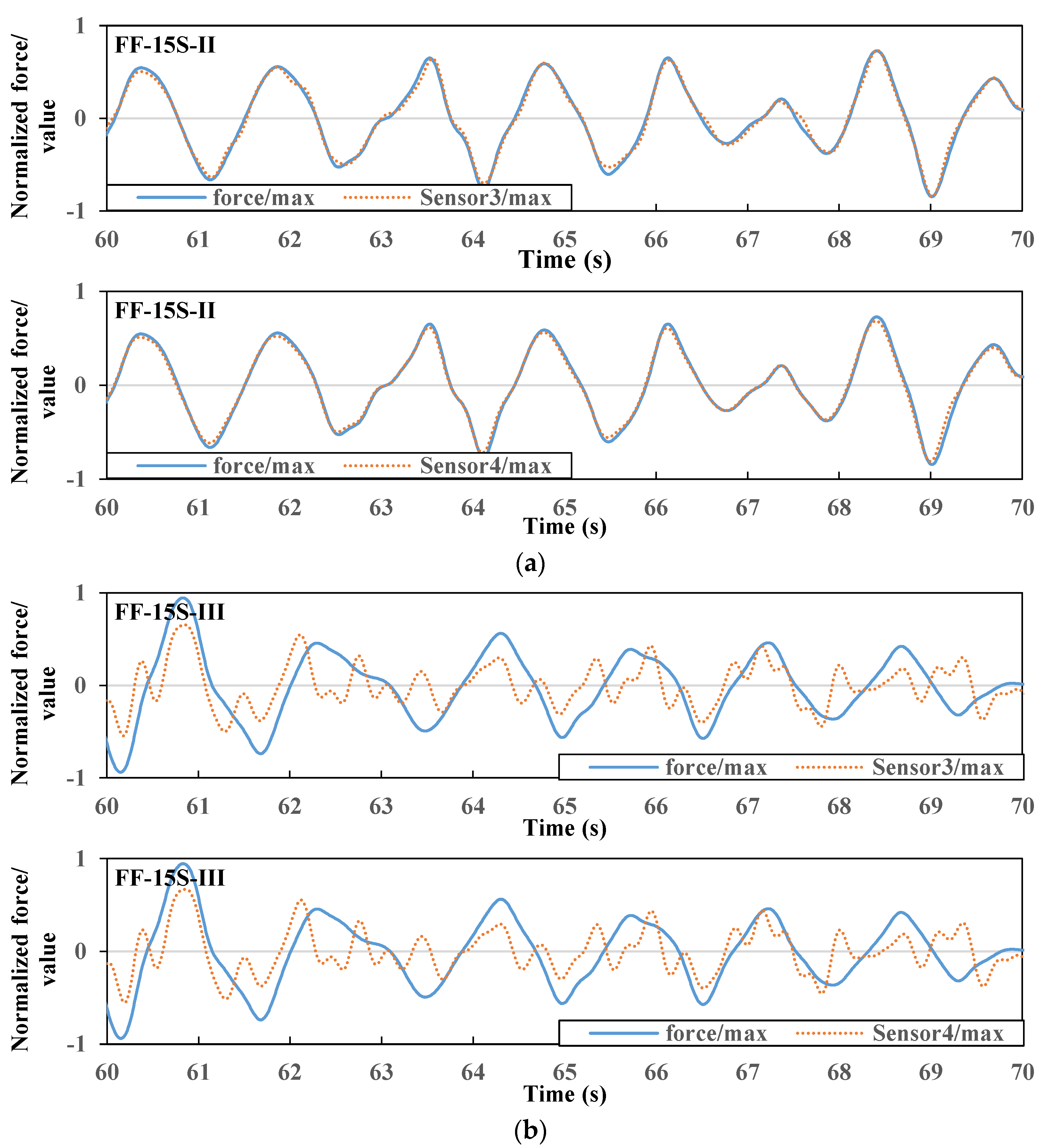
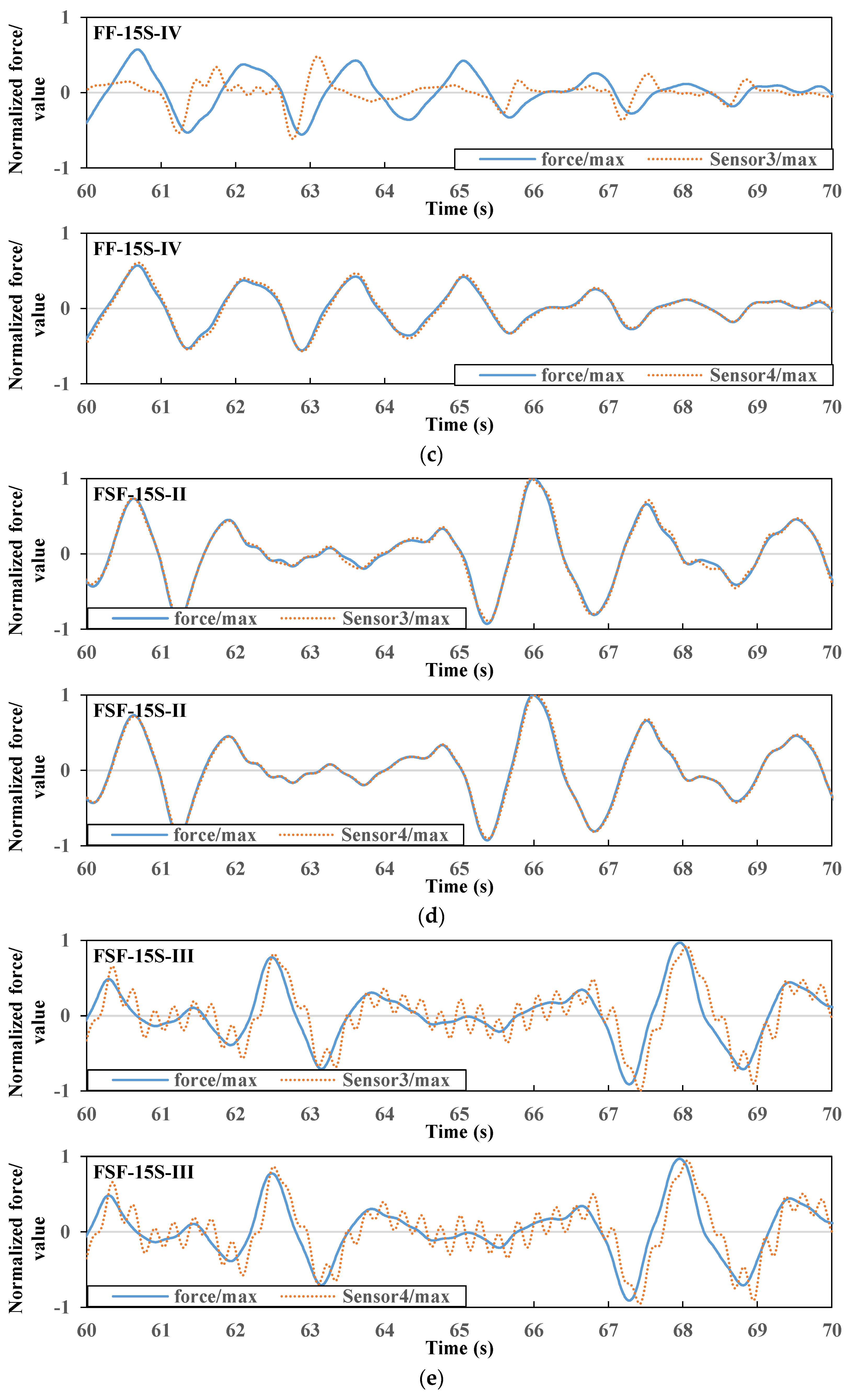


| Specimen | L (cm) | Cross Section (cm2) | Concrete Cover (cm) | fc’ (MPa) | fy (MPa) | fyt (MPa) | S (cm) | ρsh (%) | Applied Axial Force |
|---|---|---|---|---|---|---|---|---|---|
| FF-15S-II | 180 | 40 × 40 | 4 | 21 (23.2 *) | 420 | 280 | 15 | 0.61 | 0.1Agfc’ |
| FF-15S-III | 180 | 40 × 40 | 4 | 21 (22.6 *) | 420 | 280 | 15 | 0.61 | 0.1Agfc’ |
| FF-15S-IV | 180 | 40 × 40 | 4 | 21 (22.8 *) | 420 | 280 | 15 | 0.61 | 0.1Agfc’ |
| FSF-15S-II | 180 | 40 × 40 | 4 | 21 (23.9 *) | 420 | 280 | 15 | 0.31 | 0.1Agfc’ |
| FSF-15S-III | 180 | 40 × 40 | 4 | 21 (22.9 *) | 420 | 280 | 15 | 0.31 | 0.1Agfc’ |
| FSF-15S-IV | 180 | 40 × 40 | 4 | 21 (23.4 *) | 420 | 280 | 15 | 0.31 | 0.1Agfc’ |
| SF-30S-II | 180 | 40 × 40 | 4 | 21 (24.4 *) | 420 | 280 | 30 | 0.15 | 0.1Agfc’ |
| SF-30S-III | 180 | 40 × 40 | 4 | 21 (24.4 *) | 420 | 280 | 30 | 0.15 | 0.1Agfc’ |
| Mass Density, ρ | Piezoelectric Strain Constant, d11 | Piezoelectric Voltage Constant, g11 | Relative Permittivity,ε11T/ε0 | Piezoelectric Coupling Constant, K11 | Elastic Constant, Y11 |
|---|---|---|---|---|---|
| 7960 kg/m3 | 345 × 10−12 m/V | 9.8 × 10−3 V-m/N | 3000 | 0.46 | 6.3 × 1010 N/m2 |
| Planar coupling factor, Kp | Piezoelectric strain constant, d33 | Piezoelectric voltage constant, g33 | Relative permittivity,ε33T/ε0 | Piezoelectric coupling constant, K33 | Elastic constant, Y33 |
| 0.72 | 700 × 10−12 m/V | 19.5 × 10−3 V-m/N | 3500 | 0.76 | 5.2 × 1010 N/m2 |
| Specimen | Initial Yielding Point of a Main Bar | Initial Yielding Point of Stirrup | Maximum Loading Point (Positive) | Maximum Loading Point (Negative) | Concrete Spalling Point | Final Step (Strength <60%) |
|---|---|---|---|---|---|---|
| FF-15S-II | 1.0 % | 4.0% | 3.0% | −4.0% | 3.0% | 8.0% |
| (Dynamic) | (2nd) | (1st) | (1st) | (1st) | (2nd) | |
| FF-15S-III | −1.0 % | −4.0% | 4.0% | −4.0% | 3.0% | 8.0% |
| (Dynamic) | (3rd) | (1st) | (1st) | (1st) | (1st) | |
| FF-15S-IV | 0.7 % | 5.5% | 4.0% | −6.0% | 3.0% | 8.0% |
| (Dynamic) | (1st) | (1st) | (1st) | (1st) | (1st) | |
| FSF-15S-II | −1.0 % | 4.6% | 3.0% | −3.0% | 3.0% | 6.0% |
| (Dynamic) | (1st) | (1st) | (1st) | (1st) | (2nd) | |
| FSF-15S-III | 0.8 % | −1.2% | 4.0% | −4.0% | 3.0% | 6.0% |
| (Dynamic) | (Dynamic) | (1st) | (1st) | (1st) | (2nd) | |
| FSF-15S-IV | −0.9 % | −4.0% | 4.0% | −6.0% | 3.0% | 6.0% |
| (Dynamic) | (Dynamic) | (1st) | (1st) | (1st) | (2nd) | |
| SF-30S-II | 0.9 % | 2.6% | 3.0% | −3.0% | 3.0% | 4.0% |
| (Dynamic) | (3rd) | (1st) | (1st) | (1st) | (1st) | |
| SF-30S-III | −0.9 % | −2.6% | 3.0% | −3.0% | 3.0% | 4.0% |
| (Dynamic) | (Dynamic) | (1st) | (1st) | (1st) | (1st) |
| Damage Levels | Description of Damage | ||
|---|---|---|---|
| Residual Crack Widths | State of Concrete | State of Rebars | |
| Japan | |||
| I (Slight) | < 0.2 mm | Narrow cracks on concrete surfaces | - |
| II (Light) | 0.2–1.0 mm | Visible cracks on concrete surface | - |
| III (Moderate) | 1.0–2.0 mm | Local crush of covered concrete | - |
| IV (Severe) | > 2.0 mm | Cover concrete spalled off | Crushing of concrete with exposed rebars |
| V (Total damage or collapse) | Core concrete crushed | Rebars buckling | |
| Specimen | FF-15S-II | FF-15S-III | FF-15S-IV | FSF-15S-II | FSF-15S-III | FSF-15S-IV | SF-30S-II | SF-30S-III |
|---|---|---|---|---|---|---|---|---|
| Sensor 1 | 0.72 | 0.49 | 0.98 | 0.68 | 0.44 | 0.31 | 0.15 | 0.98 |
| Sensor 2 | 0.52 | 0.43 | 0.95 | 0.74 | 0.39 | 0.34 | 0.40 | 0.43 |
| Sensor 3 | 0.98 | 0.78 | 0.36 | 0.98 | 0.76 | 0.88 | 0.80 | 0.98 |
| Sensor 4 | 0.99 | 0.77 | 0.98 | 0.99 | 0.78 | 0.88 | 0.80 | 0.99 |
| Specimen | FF-15S-II | FF-15S-III | FF-15S-IV | FSF-15S-II | FSF-15S-III | FSF-15S-IV | SF-30S-II | SF-30S-III |
|---|---|---|---|---|---|---|---|---|
| Sensor 1 | 0.63 | 0.33 | 0.92 | 0.60 | 0.36 | 0.20 | 0.05 | 0.94 |
| Sensor 2 | 0.46 | 0.41 | 0.93 | 0.73 | 0.44 | 0.39 | 0.40 | 0.38 |
| Sensor 3 | 0.95 | 0.66 | 0.40 | 0.96 | 0.83 | 0.92 | 0.82 | 0.92 |
| Sensor 4 | 0.97 | 0.66 | 0.93 | 0.97 | 0.84 | 0.92 | 0.82 | 0.93 |
| Specimen | FF-15S-II | FF-15S-IV | FSF-15S-II | FF-15S-IV | SF-30S-II | SF-30S-III |
|---|---|---|---|---|---|---|
| Fmax | 191.69 kN | 209.44 kN | 193.87 kN | 212.22 kN | 199.31 kN | 210.28 kN |
| (vsi)max | 0.47 mV | 0.59 mV | 0.46 mV | 0.83 mV | 0.73 mV | 0.53 mV |
| Fmax/(vsi)max | 408.25 | 357.27 | 421.05 | 255.32 | 273.51 | 393.09 |
© 2020 by the authors. Licensee MDPI, Basel, Switzerland. This article is an open access article distributed under the terms and conditions of the Creative Commons Attribution (CC BY) license (http://creativecommons.org/licenses/by/4.0/).
Share and Cite
Chiu, C.-K.; Wu, C.-H.; Sung, H.-F.; Liao, W.-I.; Lin, C.-H. Application of Post-Embedded Piezoceramic Sensors for Force Detection on RC Columns under Seismic Loading. Appl. Sci. 2020, 10, 5061. https://doi.org/10.3390/app10155061
Chiu C-K, Wu C-H, Sung H-F, Liao W-I, Lin C-H. Application of Post-Embedded Piezoceramic Sensors for Force Detection on RC Columns under Seismic Loading. Applied Sciences. 2020; 10(15):5061. https://doi.org/10.3390/app10155061
Chicago/Turabian StyleChiu, Chien-Kuo, Chia-Hsin Wu, Hsin-Fang Sung, Wen-I Liao, and Chih-Hsien Lin. 2020. "Application of Post-Embedded Piezoceramic Sensors for Force Detection on RC Columns under Seismic Loading" Applied Sciences 10, no. 15: 5061. https://doi.org/10.3390/app10155061





